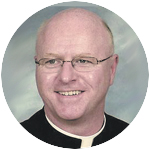
Msgr. Joseph Prior
The cornerstone in ancient buildings was the first stone laid. It was used as a “setting stone.” All the additional stones would be laid in reference to this key stone. It was the reference point for the building of the edifice. Encyclopedia Britannica notes that, symbolically, cornerstones represented “the seeds from which the building would germinate.”
The first reading for today’s liturgy, from Acts of the Apostles, recalls one of Saint Peter’s speeches as he proclaims Jesus crucified and risen from the dead. The “good news” that Peter, and the other apostles, proclaimed include this most basic message which is sometimes referred to as the “kerygma.” Jesus has died but is now risen. In his speech, Saint Peter uses the image of the “cornerstone” to describe Jesus saying, “He is the stone rejected by you, the builders, which has become the cornerstone.” The saying captures both the rejection of Jesus which leads to his passion and death; and His resurrection by which He has become the cornerstone. In the eyes of the world, His passion and death represent defeat; in the eyes of faith, it is seen as it really is, a victory.
The cornerstone image not only points to the resurrection as it refers to Him but also to everyone who puts their faith in Him. The edifice built around this cornerstone is the Church. Members of the Body of Christ, those who put their faith in Jesus, are saved by and through Him as Saint Peter notes, “There is no salvation through anyone else, nor is there any other name under heaven given to the human race by which we are to be saved.” As the cornerstone, Jesus is the foundation of the communion called the Church or the “body of Christ.” Jesus is the foundation, the reference point, the “setting stone.” Everything is built around Him and dependent on Him. Membership in this communion brings union with Him and through that we become sons and daughters of God. Saint John, in his first letter, refers to this when he writes, “See what love the Father has bestowed on us that we may be called the children of God. Yet so we are.” We are children of God because we are one in communion with His Son.
Jesus, in today’s Gospel passage, uses the image of the shepherd, the “Good Shepherd,” for himself. The shepherd does not exist on his own but always in reference to his flock. Jesus chooses this image for himself because of the relationship of love he establishes with His Church, His flock. He is the “good” shepherd. This “good” shepherd is the one who loves. His love is not expressed as an idea or a feeling, but rather an activity. The “Good Shepherd” is the one who knows His flock and will lay down His life for the flock. Jesus speaks of the Father in this passage. The reference points to the Father’s role in drawing all his creation back to Himself, to be healed and reborn. All this happens through His Son, Jesus.
So Jesus says, “This is why the Father loves me, because I lay down my life in order to take it up again. No one takes it from me, but I lay it down on my own. I have power to lay it down, and power to take it up again. This command I have received from my Father.”
Love abounds in the life of Jesus. The Father’s love moves and motivates Him. His taking on this mission of love is in response to the Father’s love. The divine love overflows for you and me and, through Jesus, draws us into the communion of divine life, eternal life. Jesus is the one who leads us into this life as the “Good Shepherd.”
The images of “cornerstone” and “shepherd” point us to different aspects of Jesus’ life-saving love. His victory over death in resurrection opens for us the path to eternal life.
We participate in this life through Him, sacramentally through Baptism, Confirmation and Eucharist, the initiation sacraments.
His love is expressed in his willingly laying down his life. In doing so he leads us through death to life.
We participate through incorporation into His Body, the Church, a living communion of love built on and in reference to the cornerstone, once rejected, Christ Jesus the Lord.
We participate, as well, through following Him where he leads, as a flock who follows its shepherd.
***
Msgr. Joseph Prior is pastor of Our Lady of Grace Parish, Penndel, and a former professor of Sacred Scripture and rector of St. Charles Borromeo Seminary.
PREVIOUS: Invitation to the Schools of Missionary Discipleship
NEXT: Jesus is the Vine, We are the Branches



Share this story